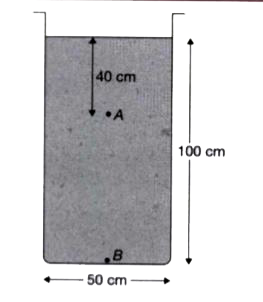A powder comprising particle of various sizes is stirred up in a vessel filled to a height of 10cm with water. Assuming the paticle to be spherical, find the size of the largest particle that will remain in suspension after 1h (density of powder =4g/cm3, viscosity of water =0.01poise).
Terminal velocity of the largest particle which is just about to settle at the bottom of the vessel is
vt=10×10−23600m/s
Let r be the radius of that particle. Then
vt=29r2(σ−ρ)ηg
where σ=4×103kg/m3 and η=0.01/10Ns/m3
After solving we get r=2.0×10−6m
Topper's Solved these Questions
- PROPERTIES OF SOLIDS AND FLUIDSBOOK - CENGAGE PHYSICSCHAPTER - PROPERTIES OF SOLIDS AND FLUIDSEXERCISE - Solved Examples
11 Videos
- PROPERTIES OF SOLIDS AND FLUIDSBOOK - CENGAGE PHYSICSCHAPTER - PROPERTIES OF SOLIDS AND FLUIDSEXERCISE - Exercise 5.1
12 Videos
- NEWTON'S LAWS OF MOTION 2BOOK - CENGAGE PHYSICSCHAPTER - NEWTON'S LAWS OF MOTION 2EXERCISE - Integer type
1 Video
- RIGID BODY DYNAMICS 1BOOK - CENGAGE PHYSICSCHAPTER - RIGID BODY DYNAMICS 1EXERCISE - Integer
11 Videos
Similar Questions
Fine particles of sand are shaken up in water contained in a tell cylinder. If the depta of water in the cylinder is 24 cm, calculate the size of the largest particle of sand that can remain suspended after the expiry of 40 minutes. Given density of sand =2.6gcm−3 and viscosity of water = 0.01 poise. Assume that all the particles are spherical and are of different sizes.
View SolutionSpherical particles of pollen are shaken up in water and allowed to settle. The depth of water is 2×10−2m. What is the diameter of the largest particles remaining in suspension one hour later? Density of pollen =1.8×103kgm−3 viscosity of water =1×10−2 poise and density of water =1×10−5kgm−3
View Solution
Knowledge Check
The dissociation of water at a certain temperature is 1.9×10−7 percent and the density of water is 1.0 g/cm3.The ionization constant of water is :
A1.8×10−6B2×10−12C1.00×10−14D2.00×10−16A cylindrical vessel is filled with water as shown in the figure. Calculate the difference in pressures due to water at points A and B. (Pressure due to air is negligible, density of water =1 g cm−3)
 A600 PaB1200 PaC6 PaD6000 Pa
A600 PaB1200 PaC6 PaD6000 PaIf a drop of water of radius 0.1 cm is broken up into a million droplets all of the same size , then the energy expended in the process will be
A197π ergB297π ergC397π ergD497π erg
Spherical particles of pollen are shaken up in water and allowed to settle. The depth of water is 2×10−2m. What is the diameter of the largest particles remaining in suspension one hour later?
Density of pollen =1.8×103kgm−3 viscosity of water =1×10−2 poise and density of water =1×103kgm−3
View SolutionThe velocity of water in a river is 72kmh−1 near the surface. If the river is 4 m deep, find the shearing stress between horizontal layers of water. Coefficient of viscosity of water = 0.01 poise.
View SolutionCalculate
(a) the actual volume of a molecule of water
(b) the radius of a water molecule assuming to be spherical (density of water =1gcm−3)
View SolutionThe base of a ractangular vessel is 10cm×15cm. It is taken at a depth of 4 m into the water. What is the pressure and thrust on the base of the vessel? Take g=10ms−2. Density of water = 103kgm−3.
View SolutionWater is filled in a flask up top a heightof 20 cm. The bottom of the flask is circular with radius 10 cm.If the atmospheric pressure is 1.01×105 Pa, find the force exerted by the water on the bottom. Take g=10ms−2 and density of water =1000 kgm^-3.
View Solution